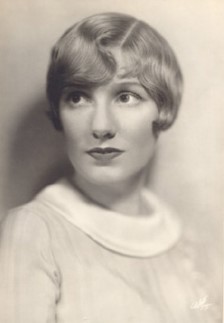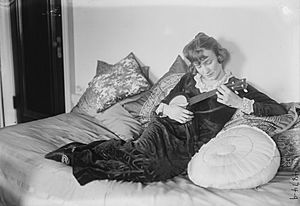Marion Harris facts for kids
Quick facts for kids
Marion Harris
|
|
|---|---|

Harris in 1924, aged 28
|
|
| Background information | |
| Birth name | Mary Ellen Harrison |
| Born | April 4, 1896 Indiana, U.S. |
| Died | April 23, 1944 (aged 48) Manhattan, New York City |
| Genres | Jazz, blues, pop |
| Occupation(s) | Singer |
| Years active | 1914–1934 |
| Labels | Victor, Columbia, Brunswick |
Marion Harris (born Mary Ellen Harrison, April 4, 1896 – April 23, 1944) was a popular American singer. She was very successful in the 1920s. Marion was known as the first white singer to become famous for singing jazz and blues songs.
Contents
Early Life and Start in Music
Marion Harris was born Mary Ellen Harrison on April 4, 1896, likely in Indiana. Around 1914, she began singing in Chicago. She performed in vaudeville shows, which were popular stage performances with different acts like singing, dancing, and comedy. She also sang in movie theaters.
A famous dancer named Vernon Castle helped her get noticed in New York City. In 1915, she made her first big appearance in a show called Stop! Look! Listen!.
Becoming a Star Singer
In 1916, Marion started recording songs for Victor Records. She sang many different types of songs. Some of her popular hits included "Everybody's Crazy 'bout the Doggone Blues, but I'm Happy" and "I Ain't Got Nobody".
In 1920, she wanted to record a famous blues song called "St. Louis Blues" by W.C. Handy. When Victor Records wouldn't let her, she joined Columbia. There, she finally recorded the song.
Marion was sometimes called "The Queen of the Blues." She recorded many blues and jazz songs throughout her career. W.C. Handy himself said that she sang blues so well that some people thought she was a Black singer. Marion once said that she sang these types of songs because they felt natural to her.
Life and Performances
Marion Harris performed in many Broadway shows during the 1920s. She often sang at the famous Palace Theatre. She also appeared in big shows like Midnight Frolic and toured the country with vaudeville acts.
In 1927, she made more recordings with Victor. She also appeared in a short film called Marion Harris: Songbird of Jazz. Later, she was in an early musical movie called Devil-May-Care in 1929. After this, she took a break from performing for a while due to an illness.
Between 1931 and 1933, Marion sang on popular radio shows like The Ipana Troubadors and Rudy Vallee's The Fleischmann's Yeast Hour. NBC radio called her "The Little Girl with the Big Voice."
In the early 1930s, she performed in London, England, for long periods. She sang at the Café de Paris and appeared on BBC radio. She also recorded music in England before she stopped performing entirely.
Later Life and Legacy
In 1936, Marion Harris married Leonard Urry, who was a theatrical agent from England. Sadly, their home was destroyed in a German rocket attack in 1941 during World War II.
In 1944, Marion traveled to New York to get medical treatment. She passed away on April 23, 1944, in a hotel fire.
Marion Harris was a pioneering singer who helped bring jazz and blues music to a wider audience.
Discography
- The Complete Victor Releases (Archeophone, 2000)
- Look for the Silver Lining (Living Era, 2006)
Images for kids
See also
 In Spanish: Marion Harris para niños
In Spanish: Marion Harris para niños




